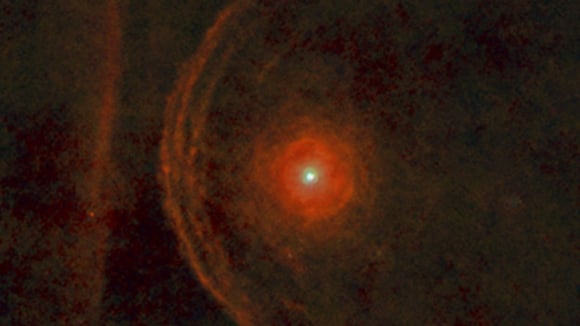Posted in Science, 23rd January 2013 16:45 GMT
Earth's nearest supergiant red star Betelgeuse is its on its way to a spectacular supernova explosion when it collides with a nearby dust bar.
The European Space Agency's Herschel telescope has snapped a new image of Betelgeuse, which sits just above and to the left of the Orion constellation in the visible night sky, showing an obstacle in the path of the brightly shining sun.
The orange-red star is a thousand times the diameter of our Sun and shines a hundred thousand times more brightly, but its expansion into supergiant hunk has come at a cost. The body has shed a significant amount of its outer layers, which can be seen in Hershel's picture.
The infrared view shows how the star's fierce winds are whipping across the surrounding space, creating a bow shock around Betelgeuse as it hurtles through the cosmos at 30km a second. This series of broken dusty arcs lie in front of the star, showing its direction of motion. Around the star itself lies a lopsided halo of material, likely to have resulted from localised, clumps of dusty debris.
But further out in space, a bar of what appears to be more dust is lying right across Betelgeuse's path. Boffins have previously thought that this bar could also have originally come from the star, but analysis of this image suggests that it's either a linear filament linked to the galaxy's magnetic field or the edge of a nearby interstellar cloud, lit up by the star's bright light.
If the bar is a completely separate object, Betelgeuse's outer arc will crash into it in just five thousand years and the red star itself will follow, around 12,500 years later. ®

No comments:
Post a Comment